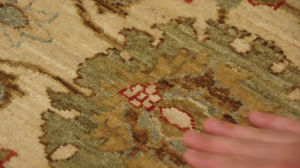This week I am going to talk about hand knotted Peshawar Rugs , also known as Chobi rugs. I will be covering the history, design, and ways to identify this particular type of rug.
Peshawar Rugs History:
The influences of migrations, invading armies, and trade have left Pakistan with a rich culture, which is visible in the arts and crafts of this region. It’s not known when the first carpets were woven in the Pakistan area, although it is claimed that weaving was probably introduced by ancient Scythians. In the 16th century the Mogul emperor Akbar established carpet-weaving workshops bringing Persian weavers to his imperial court. The carpets woven in these court workshops were very similar to Persian rugs in weave as well as in the designs used. Soon a new Mogul style began to emerge from the workshops. Later, in 1947 the new government in Pakistan recognized the need for industry and employment. Government subsidies were granted to the still-small Pakistani carpet-weaving industry, markets. Soon Pakistan emerged as one of the world’s leading manufacturers of Hand Knotted Oriental carpets.
Peshawar is the capital city of the North-West Frontier Province, in Pakistan. The city located on the Afghanistan-Pakistan border has been an important center for trade and commerce in the region. The city is more famous for its traditional carpets or as more commonly known as Peshawar rugs.
Peshawar Rugs Design:
Peshawar rugs are peculiar carpets that are characterized by:
• Artistic designs
• Subtle shifts in their color
• Materials can be wool or Wool and Silk
• Vegetable dye
Peshawar rugs are finely knotted with wool pile and cotton warp and weft threads. Silk and artificial silk is occasionally used in the pile to accentuate certain motifs. The Pakistani rugs are durable, take dye well, and are easily spun. The finest quality rugs are woven with local wool that has been blended with merino wool imported from New Zealand, Korea, and Australia. This imported wool contains more lanolin, has a longer staple, and is stronger, hence a more durable rug.
Two types of weaves are used in Pakistani rugs:
• The Mori weave
• The Persian weave
In both types of weave the quality or fineness of the weave is expressed by a set of numbers in the form of a fraction- for example, 9/16 or 11/12.
The top figure is the number of horizontal knots in a linear inch; the bottom figure is the number of vertical knots in a linear inch. This way, the number of knots per square inch is easily computed by multiplying the two figures together.
The Persian weave, used in rugs with a wide variety of Persian designs, resembles the back of Persian rugs with approximately the same number of vertical knots in a horizontal inch as in a vertical inch, although the number of horizontal knots per inch is slightly less than the number of vertical knots per inch.
Persian –weave rugs may be woven either single or double knots. The quality grades range from 13/15 to 18/20, with intermediate grades of 14/16 and 16/18. The color combinations are esthetically pleasing and not harsh. Since the 1980s U.S. embargo of Iranian carpets, the production of Persian design Pakistani rugs has increased dramatically.
With conviction and by virtue of innovating newer designs, weavers, floral and geometric artwork, Catalina rug, Inc. is a leader in the Pakistan carpet/rug industry ensuring to deliver zero defective products. Furthermore, Catalina rug has an edge on specific washing and finishing brand new or antique finish rugs to meet the peculiar requirements of our valued clients.



